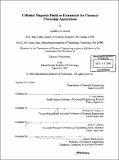| dc.contributor.advisor | T. Alan Hatton, William H. Green, Jr., and Paul E. Laibinis. | en_US |
| dc.contributor.author | Moeser, Geoffrey D. (Geoffery Dawson), 1976- | en_US |
| dc.contributor.other | Massachusetts Institute of Technology. Dept. of Chemical Engineering. | en_US |
| dc.date.accessioned | 2005-09-26T19:36:33Z | |
| dc.date.available | 2005-09-26T19:36:33Z | |
| dc.date.copyright | 2003 | en_US |
| dc.date.issued | 2003 | en_US |
| dc.identifier.uri | http://hdl.handle.net/1721.1/28291 | |
| dc.description | Thesis (Ph. D.)--Massachusetts Institute of Technology, Dept. of Chemical Engineering, 2003. | en_US |
| dc.description | Includes bibliographical references. | en_US |
| dc.description.abstract | The feasibility of using high gradient magnetic separation (HGMS) to separate the Fe₃0₄ nanoparticles was studied in this work. We present a general model for nanoparticle capture based on calculating the limit of static nanoparticle buildup around the collection wires in an HGMS column. Model predictions were compared successfully with experimental results from a bench-scale HGMS column. Permanent capture of individual nanoparticles is limited by diffusion away from the wires; however, 60-125 nm aggregates of particles can be captured permanently in the bench-scale column. The model provided estimates of the minimum particle size for permanent capture of individual nanoparticles and nanoparticle aggregates. | en_US |
| dc.description.abstract | This focus of this thesis is a novel class of water-based magnetic fluids that are specifically tailored to extract soluble organic compounds from water. Magnetic fluids are colloidal dispersions of magnetic nanoparticles that do not settle in gravitational or moderate magnetic fields due to their small size and do not aggregate because of their surface coatings. These materials offer several potential advantages over traditional methods of organic separation, such as activated carbon adsorption. For example, magnetic fluids possess a large surface area for separation while avoiding porous structures that introduce a high mass transfer resistance. The magnetic fluids were prepared by precipitation and consist of a suspension of [approximately]7.5 nm diameter magnetite (Fe₃0₄) nanoparticles coated with a [approsimately]9 nm thick bifunctional polymer layer comprised of an outer hydrophilic polyethylene oxide (PEO) region for colloidal stability, and an inner hydrophobic polypropylene oxide (PPO) region for solubilization of organic compounds. Characterization of these materials revealed the particle dimensions and magnetic properties. In addition, we examined the colloidal stability of the magnetic fluids over a broad range of conditions. The structure of the polymer shell, which was examined with neutron scattering and lattice calculations, shows some evidence of segregation of the PEO and PPO chains. The magnetic fluids exhibit a high capacity for organic solutes, with partition coefficients between the polymer coating and water on the order of 10³ to 10⁵, which is consistent with values reported for solubilization of these organics in PEO-PPO-PEO block copolymer (Pluronic) micelles. | en_US |
| dc.description.statementofresponsibility | by Geoffrey D. Moeser. | en_US |
| dc.format.extent | 168 p. | en_US |
| dc.format.extent | 11050797 bytes | |
| dc.format.extent | 11071706 bytes | |
| dc.format.mimetype | application/pdf | |
| dc.format.mimetype | application/pdf | |
| dc.language.iso | en_US | |
| dc.publisher | Massachusetts Institute of Technology | en_US |
| dc.rights | M.I.T. theses are protected by copyright. They may be viewed from this source for any purpose, but reproduction or distribution in any format is prohibited without written permission. See provided URL for inquiries about permission. | en_US |
| dc.rights.uri | http://dspace.mit.edu/handle/1721.1/7582 | |
| dc.subject | Chemical Engineering. | en_US |
| dc.title | Colloidal magnetic fluids as extractants for chemical processing applications | en_US |
| dc.type | Thesis | en_US |
| dc.description.degree | Ph.D. | en_US |
| dc.contributor.department | Massachusetts Institute of Technology. Department of Chemical Engineering | |
| dc.identifier.oclc | 54938604 | en_US |
